Classical Music on Stamps
A weekly feature
presented by David Barker
11. French composers on French stamps - Part 1
French stamps have long been regarded by many as among the most
consistently well-designed, and as a collector, I share that opinion.
Music has been a rich source of inspiration for their designers, and
more than 30 composers have been featured over the years. The great
majority have been home-grown, and they are the ones I will present here
and next week.
I will omit the Debussy as it has already been included in an earlier
column (2). Only two composers have had a return visit from the
designers: that Berlioz is one of them is not surprising, but that
Daniel Auber is the other is less expected.
They are presented in chronological order, so that the change in
design over the years can be appreciated. You will see that the last two
stamps, from the early 1960s, are the first to use more than one colour.
The 1936 Berlioz design was reused two years later for another issue, in
violet.
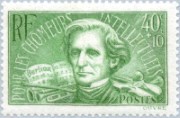 |
 |
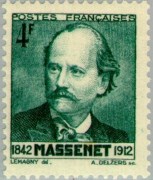 |
 |
| Berlioz (1936) |
Chabrier (1942) |
Massenet (1942) |
Gounod (1944) |
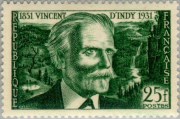 |
 |
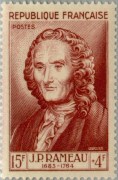 |
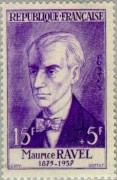 |
| d'Indy (1951) |
Saint-Saëns (1952) |
Rameau (1953) |
Ravel (1956) |
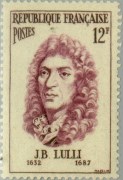 |
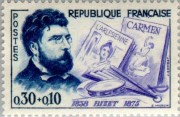 |
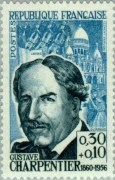 |
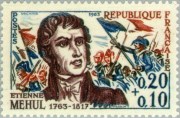 |
| Lully (1956) |
Bizet (1960) |
G Charpentier (1962) |
Mehul (1963) |
12. French composers on French stamps - Part 2
Back to France we go. As I said last week, I am only including
home-grown composers, but this doesn't actually omit many others. Apart
from Beethoven and Mozart, the only other composers to have been
honoured on French stamps are almost honorary Frenchmen anyway: Chopin,
Franck and Honegger.
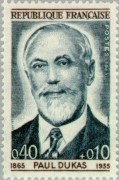 |
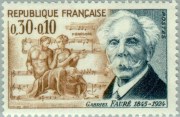 |
 |
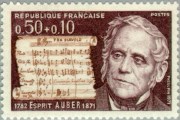 |
| Dukas (1965) |
Fauré (1966) |
F Couperin (1968) |
Auber (1971) |
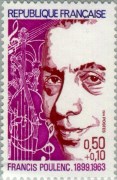 |
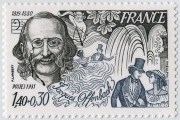 |
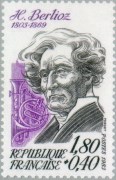 |
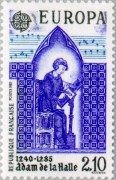 |
| Poulenc (1974) |
Offenbach (1981) |
Berlioz (1983) |
de la Halle (1985) |
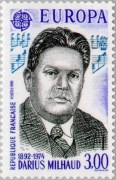 |
 |
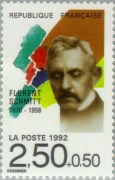 |
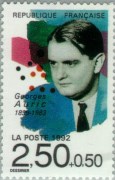 |
| Milhaud (1985) |
Satie (1992) |
Schmitt (1992) |
Auric (1992) |
 |
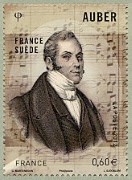 |
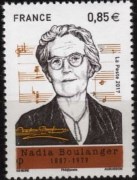 |
|
| Tailleferre (1992) |
Auber (2012) |
N Boulanger (2017) |
|
13. Jean Sibelius
No great surprise that Finland would dedicate a number of stamps to
its greatest composer. The first was released in 1945, commemorating his
80th birthday, and then following up 12 years later for his death. Only
one other country recognised his death on a stamp, that being Romania.
The 100th anniversary of his birth in 1965 saw another Finnish stamp,
but it would be almost 40 years before Finland issued any more
Sibelius-related stamps, the first in 2002 recognising the monument
erected in his name, the second not showing his face or giving his name,
but it is a photograph of him playing the piano. Neither of these stamps
seems to coincide with a Sibelius anniversary.
The 150th anniversary of his birth in 2015 gave an opportunity for
more issues, three from Finland in an miniature sheet, and two from Portugal.
Finally, we have another entry in the "Most unlikely composer-related
stamp" competition. In 1988, there was a major stamp exhibition in
Finland, and the landlocked African country of Lesotho chose to issue a
stamp with an image of the Sibelius monument, surprising in itself, but
made all the more curious by the presence of Micky Mouse and Goofy!
14. Swiss composers
This topic was prompted by sorting through a recent acquisition of
Swiss stamps. Switzerland is not renowned for its composers, but
certainly Arthur Honegger and Frank Martin have a reasonable
presence in the catalogue. However, I'm sure I will not be alone in not
recognising some of the other names that appear below.
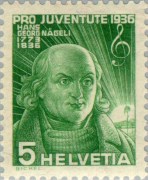 |
 |
|
Hans Georg Nägeli |
Alberich Zwyssig |
These two belong to long-running series of Swiss stamps issued
for charitable purposes. The "Pro Juventute" releases raise money for an
organisation of that name, which is dedicated to supporting the rights
and needs of Swiss children and youth, while the "Pro Patria" series
(this translates as "for our nation") benefits social and cultural works
of national public interest. Regarding the second stamp, where the
likeness of the composer does not appear, it was Zwyssig (oh, how I wish
names were allowed in Scrabble) who wrote the psalm which is used as the
country's national anthem.
 |
 |
 |
| Othmar Schoeck (1969) |
Joseph Bovet (1978) |
Frank Martin (1985) |
Arthur Honegger appears not only on a Swiss stamp, but also on French
and German ones as well, the latter two celebrating the 100th
anniversary of his birth. Given his association with Les Six and the
time he spent in Paris, the former is not unexpected.
Aficionados of modernist music - that counts me out - may recognise
the last two names from these 2010/11 stamps.
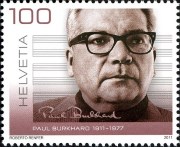 |
 |
|
Paul Burkhard |
Heinrich Sutermeister |
15. Wagner operas from Germany - 1933
Given how much Hitler loved Wagner's music, it is perhaps
unsurprising
that the first stamps issued under the Third Reich featured his operas.
They were charity stamps, issued in part to raise money for "emergency
relief". As beautifully designed as they undoubtedly are, it is difficult to ignore
their political connotations, especially if you turn them over and find the
swastika watermark.
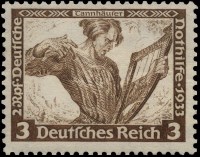 |
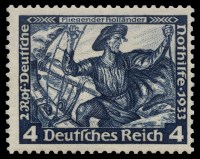 |
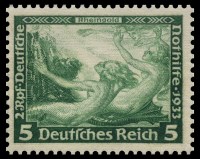 |
| Tannhauser |
Die Fliegende Holländer |
Das Rheingold |
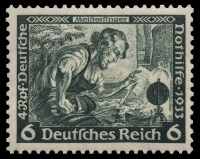 |
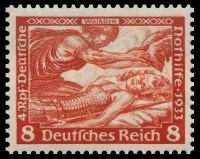 |
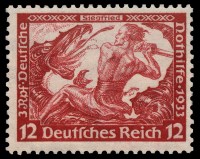 |
| Die Meistersinger von Nürnberg |
Die Walküre |
Siegfried |
 |
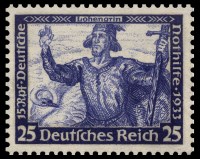 |
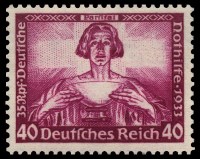 |
| Tristan und Isolde |
Lohengrin |
Parsifal |
| |
 |
|
16. Tchaikovsky's Swan Lake
From opera to ballet, and one of the most popular of all,
philatelically as well. No great surprise that Russia, and the former
Soviet Union, should celebrate this work and its composer, visiting the
topic four times from 1958, in conjunction with the Tchaikovsky
International Music Competition, to 1993, the centenary of his death.
Russia is outdone by its former political ally, Cuba, which has issued five
stamps related to Swan Lake. Admittedly four of those are more about
celebrating the Cuban National Ballet, including its 50th and 60th
anniversaries in 1998 and 2008. The other is a 1993 Tchaikovsky
centenary issue (second row left).
That leaves us with stamps from three other countries: Austria in
1969, celebrating 100 years of the Vienna Opera (?), New Zealand in 2003
for the 50th anniversary of the Royal NZ Ballet, and France in 2016,
with a release that celebrates the ballet itself.
17. The 200th anniversary of Beethoven's birth
In 1970, nineteen countries recognised this anniverary on a total of 30
stamps. This has been only exceeded by Mozart anniversaries, with both the 200th of
his death in 1991, and the 250th of his birth in 2006 generating more
philatelic interest. However, let me put that into context: the number
of stamps being issued by all countries from the 1990s onwards is far
greater than in 1970.
Some of the nineteen contries were the expected ones: Austria, and
both Germanys. East Germany released two, one in January, the other
December, the latter being the month of his birth.
Czechoslovakia, Hungary, Romania and the USSR also have significant
classical traditions, so they too are among the expected list. I have to
say that the Romanian designer's "interpretation" of a
well-known Beethoven portrait is a rather interesting one.
Two countries seriously celebrated the anniversary with sets of five,
mostly using different portraits of the composer. Being in Europe, Albania
has a connection, albeit fairly slight, to the Western classical
tradition, but as for the small South American nation of Surinam ...
Before we leave Europe, there are also issues from Bulgaria, Greece and
Monaco. This means none from France, Poland, the Scandinavian and
Benelux nations, Spain, Portugal or the UK.
Nine stamps remain, from seven countries: Cameroon, Dahomey (2),
India, Mexico, Niger, Senegal (2) and Sharjah. As you can see, Mexico
hasn't simply utilised a portrait of the composer,
opting instead for two bars of the manuscript of the Ninth Symphony.
18. Composers on American stamps
The USA has released well in excess of 10,000 stamps since the first
one
in 1842. The number featuring classical composers is, however, quite
small: just fourteen. Overlap with the worlds of jazz and musical theatre
does make for tricky distinctions, but I think most would agree that
great musicians such as Rodgers and Hammerstein, Lerner and Loewe and
Duke Ellington are not generally considered as classical composers (and
yes, I know that there is a symphony by Ellington recorded on Chandos).
Interestingly, there is one major American composer who is absent
from the list. I will wait to the end to let you know who, if you haven't
already worked it out.
In 1940, the USA released a number of sets of stamps, in similar
designs, celebrating authors, poets, scientists, educators and
musicians. Among the latter group were John Philip Sousa, Victor
Herbert, Edward MacDowell and Ethelbert Nevin; Stephen Foster was the
other in the set.
We then move forward more than 30 years to a set of American artists
in 1973,
one of which was George Gershwin.
In 1982, we find Igor Stravinsky included in the Great Americans
definitives series. For those not up on stamp terminology, a definitive
is a stamp generally released in a large number of numerous
denominations with similar designs, intended for long term release in
large quantities. The best known example are the UK's Queen's head
stamps (known to collectors as Machins after the designer).
Throughout the 1990s, the US Postal Service released a number of sets
entitled American Music, mostly featuring great musicians from other
genres. In 1997, Samuel Barber, Louis Gottschalk, Ferde Grofé and
Charles Ives were celebrated. In 1999, in a set dedicated to film score
composers, we find Erich Korngold and Franz Waxman, and in a set of
musical theatre composers, George and Ira Gershwin and Meredith Willson.
Have you spotted who is missing? Quite amazingly, perhaps the most
famous of all - Aaron Copland!
19. The Chopin International Piano Competition
There's no doubting how revered Chopin is in his homeland of Poland,
and the country's postal service has issued numerous stamps celebrating
him, but those are for another day. Today's column is specifically about
the prestigious piano competition named after him that was first held in
1927, and since 1955 is held every five years. Previous winners include
Lev Oborin (1927), Maurizio Pollini (1960), Martha Argerich (1965),
Garrick Ohlsson (1970) and Krystian Zimerman (1975).
It would be one of the most highly regarded competitions of its
type, along with the Tchaikovsky and Cliburn, but I'm fairly sure it is
the only one that has been so regularly celebrated on stamps. Poland has
released twelve stamps connected to eight of the competitions.
In 1954, leading up to the 1955 event, a set of three was issued, and
then in the competition year, another two were released.
Since then, the competition has been a regular visitor to the Polish
postage release list.
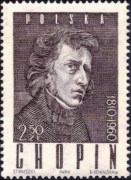 |
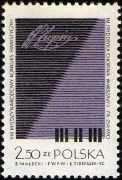 |
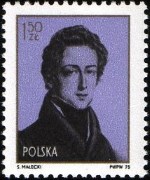 |
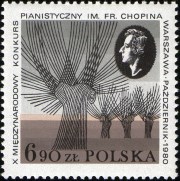 |
|
1960 |
1970 |
1975 |
1980 |
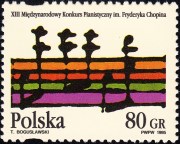 |
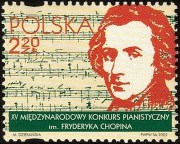 |
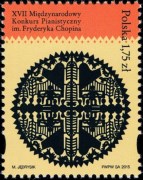 |
|
|
1995 |
2005 |
2015 |
|
20. The Prague Spring Music Festival
This famous festival was first held in 1946, and continues to this
day. Since 1952, the festival has opened on May 12 — the anniversary of
the death of Bedřich Smetana. In the 1950s, it was a regular feature on
Czechoslovakian stamps, the first issued in 1951, celebrating not
surprisingly the country's two foremost composers, Smetana and
Antonín Dvořák.
The 1952 release focussed on Beethoven (I'm not sure why) and also
included an image of the Rudolfinum, one of Prague's most famous concert
halls.
1953 saw a return to homegrown musicians, Josef Slavík, a 19th
century composer/violinist, and Leoš Janáček.
I presume that the festival was held in 1954, but there were no
stamps featuring it that year. In 1955, the stamp designs avoided
specific subjects, and were inspired by classical imagery.
In 1956, the theme of the festival stamps was the 200th anniversary
of Mozart's birth, though three of the stamps - the 45, 60 & 1.40 -
featured local composers. Bertramka House was the house owned by
František Dušek & his wife Josefína Dušková where Mozart stayed in
Prague in 1787, while the Nostic Theatre held the premiere of Don Giovanni.
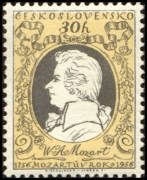 |
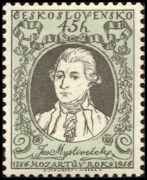 |
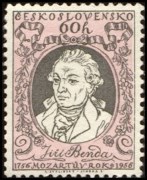 |
|
Mozart |
Josef Mysliveček |
Jiri Benda |
 |
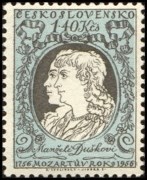 |
 |
|
Bertramka House |
Josefína Dušková &
František Dušek |
Nostic Theatre |
1957 was the last hurrah for large scale philatelic recognition of
the festival, featuring six Czech composers, the first three of whom
were new names to me.
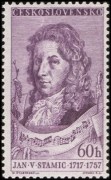 |
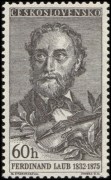 |
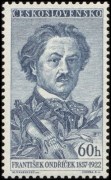 |
|
Jan Stamic |
Ferdinand Laub |
František Ondříček |
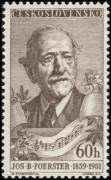 |
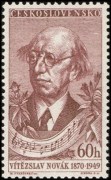 |
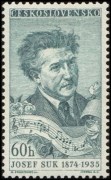 |
|
Josef Foerster |
Vítĕzslav Novák |
Josef Suk |
And then there was silence ... almost: just two more stamps, one in 1967 and
another in 1986.
<<< Newest entries
